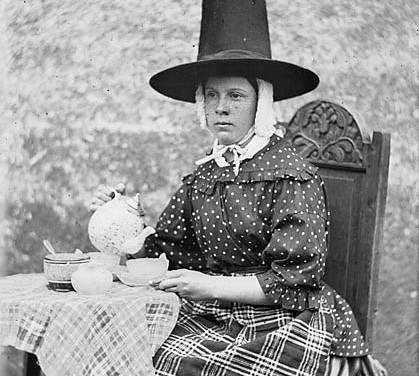The idea of Welsh food culture may seem like a misnomer to some. But there are a number of ways of preparing, sharing and eating food that have been common to Wales up to the present day. These are now the childhood memories of the older generation in Wales. They all remain living traditions, even if some currently seem to be on their last legs:
- Buttermilk dishes
Dymunol, da yw ymenyn,—a chaws,
A chig- purlon enllyn;
Goreu o ddim geir i ddyn,
Lwyth haner o laeth enwyn.
(Cadwgan Fardd, Medi 1885 Y Drych)
‘Butter and cheese are pleasant and good
And meat a hearty food
But best of all for humankind
Half a weight of buttermilk’
This little englyn, published in a mass market Welsh magazine in the 1880s captures several key things; the preponderance of dairy in Welsh cooking, the poetic form used to praise everyday local food, and the love of buttermilk (llaeth enwyn). Poured over new potatoes, put into cakes (when eggs weren’t available), used in puddings and porridges and drunk with a touch of ginger, this byproduct of churning was ubiquitous. It was also – correctly – viewed as having beneficial health effects due to its fermented nature.
- Home baking on the griddle
Griddles (gradell) or bakestones (maen/llechfaen) are versatile implements that have been used in Wales for baking in some form since before records began. But they are far from only being useful to make Welsh cakes – a whole range of bakestone cakes, turnovers, pancakes and other baked goods owe their existence to the presence of griddles in Welsh kitchens. And the most important of the bakestone cakes are not in fact sweet at all – oatcakes (bara ceirch).
- Sioni Winwns
These Breton onion sellers have been a part of the Welsh food landscape since the early 1820s, with their sweet pink onions a favourite with discerning cooks. Many returned year after year, and though they went to other parts of the British Isles, a disproportionately large number came to Wales. Memories that some seemed to speak Welsh were indeed correct, with the similarities between Welsh and Breton allowing some who might spend 6 months of the year in Llanelli or Porthmadog to pick up the language with ease. The tradition continues, down to the use of bikes to advertise the plaited onions, though the sellers tend now to be Breton language students looking to improve their English, rather than Welsh.
- Cockles and other shellfish
Vans would drive around the towns and cities of South Wales selling cockles and other fresh seafood caught along the coast until the early 2000s. Seafood cocktails can still be had as a protein-rich snack from Cardiff market among others. Always a working class food – as was laver bread – the taste for these seafoods has diminished over the past few decades, and the lion’s share of the cockle harvest is now exported to Spain and other countries, where they are enjoyed as a delicacy.
- “Te capel”
“Yr oedd y capel wedi ei addarno yn brydferth; a gallesid meddwl wrth fyned i mewn iddo mai i ardd fiodeu yr oedd- yell yn myned. Cafwyd gwledd-de gysurus; ac ym- ddangosai pawb yn llawen a boddlawn.” Baner ac Amserau Cymru, Mehefin 1866; Capel Newydd, Machynlleth
‘The chapel had been beautifully decorated, and you might think as you entered into it that you had come into a flower garden. A comfortable feast-tea was hard, and everyone was merry and content’ (June 1866, Machynlleth)
The tradition of holding a chapel tea-time, with tea and cakes in a vestry or hall after a service, Cymanfa Ganu or other occasion, is one that united people from all parts of Welsh society for a hundred and fifty years. They are social occasions above all, with no alcohol ever served, but a steady contented hum of chatter and the enjoyment of tea and baked goods. Chapel teas, with bone china holding bara brith, are still held in all parts of the country, but now frequented generally only by aging congregations.

I have wonderful memories of moving to Wales from London when I was 7 years old. The house we moved to had a moderate sized garden, with established fruit trees, a pig sty, a garden loo which today would be called a compost toilet. We grew fruit and veg which provided food for all seasons by preserving and pickling, all stored in the larder. My grandmother – oh and me, made butter and laeth enwin, from milk from the farmer just down the road.The local farmer also had a field for growing all the additional veg that we needed. We foraged for blackberries, mushrooms and hedgerow pickings. Just special memories that will stay with me always. Suzanne
I have sent a story, not sure that I have submitted it to the correct site.
Hi Suzanne – thanks for the comment and the lovely recollection!